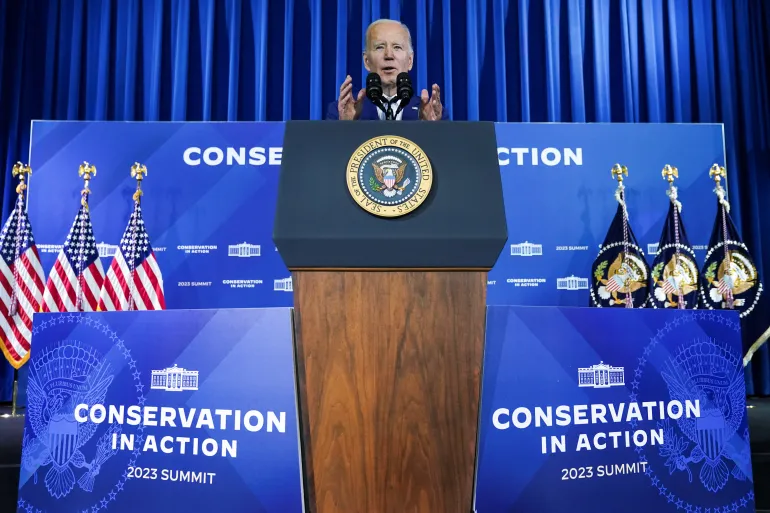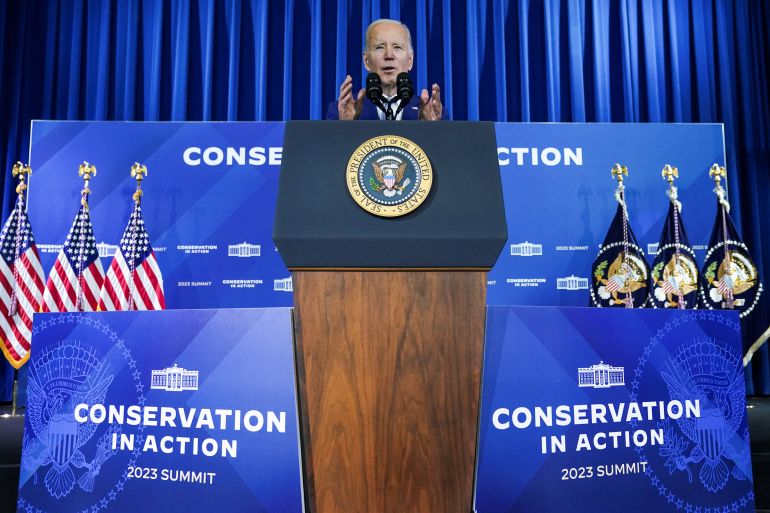Biden administration unveils two new national monuments in the US

The monuments, announced at a conservation summit, would protect the areas from development and advance Biden’s goals.

United States President Joe Biden has designated two new national monuments on Tuesday, protecting nearly 200,000 hectares (500,000 acres) of wilderness in the states of Texas and Nevada.
The announcement comes nearly a week after his administration approved a controversial oil drilling project in Alaska, the largest such proposal for federal lands.
Speaking on Tuesday at the White House Conservation in Action Summit, Biden named Castner Range in Texas and Avi Kwa Ame in Nevada, also known as Spirit Mountain, as national monuments under the authority of the Antiquities Act of 1906.
He also issued a presidential memorandum to Secretary of Commerce Gina Raimondo, calling on her office to designate some two million square kilometres (777,000 square miles) of ocean south of Hawaii as a new national marine sanctuary.
“Our country’s natural treasures define our identity as a nation,” Biden told the summit audience. “They’re a birthright we have to pass down to generation after generation.
Tuesday’s designations mark another step towards Biden’s goal of conserving 30 percent of US land and water by 2030, part of an executive order he issued in January 2021, one week after his inauguration.
But the announcement was not without controversy. For years, Indigenous tribes and conservation groups had lobbied the government to name Avi Kwa Ame a national monument, and Biden teased increased protections for the area in November at the first White House Tribal Nations Summit in six years.
A desert landscape rugged with canyons and rock formations, Avi Kwa Ame is considered the spiritual birthplace of 10 Yuman-speaking tribes. Its white granite peak and surrounding lands harbour Gila monsters, desert tortoises and bighorn sheep among its creosote bushes and pinyon pines.
About 13,564 hectares (33,518 acres) in the area were already protected as federal wilderness, but Biden’s announcement on Tuesday expands protections to an estimated 200,000 hectares (500,000 acres), placing them off limits to development.
That comes over opposition from energy companies. For years, Crescent Peak Renewables has sought approval to develop wind turbines and other facilities on the site, which is wedged in the southern tip of Nevada, near California and Arizona.
In response to the increased federal protections for Awe Kwa Ame, Nevada’s Republican Governor Joe Lombardo issued a statement criticising Biden for failing to consult with local politicians.
“Upon learning that the President was considering unilateral action, I reached out to the White House to raise several concerns,” Lombardo wrote.
“While I’m still waiting for a response, I’m not surprised,” he said of Tuesday’s announcement. “This kind of ‘Washington Knows Best’ policy might win plaudits from unaccountable special interests, but it’s going to cost our state jobs and economic opportunity.”
Indigenous groups, however, applauded Biden’s actions. Timothy Williams, chairperson of the Fort Mojave Indian Tribe, spoke at Tuesday’s summit, saying his community was “filled with joy” upon learning that Awe Kwa Ame would be protected.
“It is a place we know as our creation. It is the beginning of our traditional songs. And it is the place that Native nations throughout the southwest hold sacred,” he explained. “What had once been a distant dream for our people suddenly seemed possible.”
Nevada remains a critical swing state for Biden as he weighs a likely presidential run in 2024. In the 2022 midterm elections, incumbent Democrats lost the Nevada governor’s race but retained a pivotal seat in the US Senate, resulting in a mixed bag overall for the party.
The second national monument, Castner Range, is set to be located in the deep-red state of Texas. Located near the city of El Paso, the range is a site of historic significance for local Indigenous people and served as a World War II training site. It also contains 40 known archaeological sites and is a habitat for animals like the western burrowing owl.
“Castner Range has been an indelible part of US Army history, but now it’s time to write a new chapter about the future of this natural treasure,” Under Secretary of the Army Gabe Camarillo said in a press release on Tuesday.
But protesters outside the White House conservation summit pushed the Biden administration to do more to protect the country’s environmental resources and tribal lands. Of particular concern was the Alaska drilling project, known as Willow, which would extract 180,000 barrels of oil a day from the Arctic wilderness.
“No more drilling on federal land,” the protesters cried, unfurling a banner that read, “Stop the Willow oil project.”







